Big, powerful, and beautiful, draft horses are truly a sight to behold. Aside from their beauty, find out how these horses have played an important role throughout human history. However, what is a draft horse?
A draft horse is a large horse that has been bred to do heavy work, such as plowing, farming, forestry, and hauling large loads. Draft horse breeds are commonly known for their well-muscled builds and docile temperaments, with many breeds sporting feathering on their legs.
For hundreds of years, people have relied on draft horses to perform hard labor. Selective breeding has led to the development of several different breeds.
The most common draft horse breeds are the Shire, Clydesdale, Percheron, Belgian Draft, and Haflinger. Also known as cold-blooded or work horses, most stand between 16-19 hands tall, typically weighing upwards of 1,500 pounds.
History of Draft Horses
Over thousands of years, humans have carefully bred horses for different purposes. During medieval times, larger horses were being bred for war and farming. However, though sturdy, these horses were not as large as modern-day draft horses.
The draft horses we know today rose to popularity in the 19th century, when the demand for a large powerful horse grew. Draft horses were commonly being used for farm work, hauling freight and pulling large carriages. People used draft breeds as their primary source of horsepower, which helped lead to the rise of the Industrial Revolution.
Even as farm machinery and cars rose to power, many people still relied on draft horses to get the job done. During WWI and WWII, these hardy horses were used for the transportation of heavy equipment on the battlefield.
The mechanization and technical advances of the early 20th century has nearly caused the extinction of many work horse breeds. By the 1950s and ’60s, their numbers were critically low.
Though machinery may have taken the majority of jobs that were once held by draft horses, today they are still used for showing, pleasure riding and driving, logging, and plowing small farms.
Luckily, dedicated enthusiasts and breed societies have worked extremely hard to preserve these breeds for future generations. And so it happened that draft horses found their place in modern society and thrive once again.
8 most common draft & work horse breeds Shire
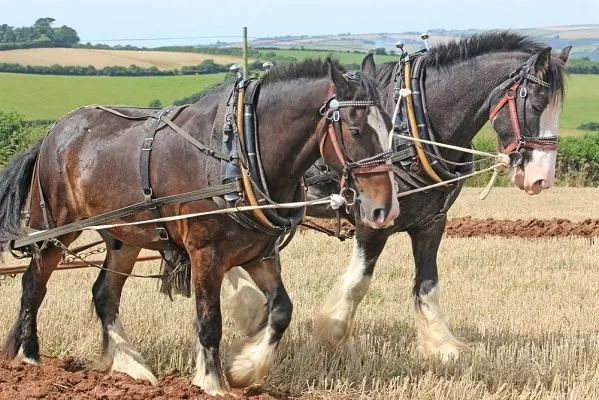
jennyt / Shutterstock.com
Powerful and mighty, Shire horses are known for their incredible strength and size. Shires usually stand between 16-18 hands tall and generally weigh between 1,800-2,400 pounds. They are known for their well-arched necks, slight Roman noses, muscled bodies, feathering, and are often black, bay or gray in color.
Shire horses were established as a breed in the mid-1800s in the United Kingdom, though their origins are much older than that. They are believed to be descendants of the Great English Horse that carried men into battle. As the breed developed, they were used for agriculture, hauling and even as a war horse during WWI and WWII.
Today Shires are commonly used for plowing, driving and riding, and are wonderful show horses. Their deep shoulders and wide chests make them a powerful pulling horse.
Considered the largest horse breed, a Shire horse can easily pull a load of several tonnes! In fact, Shires hold the record for the most weight pulled by a pair of horses after two Shires pulled an enormous 50-tonne load back in 1924.
These magnificent horses have also claimed many world records, as the title for the largest horse ever belongs to a Shire named Samson (later Mammoth) born in 1846 who was 21.2 hands tall and weighed an impressive 3,360 pounds.
Sadly, the number of Shire horses has drastically fallen during the mid-20th century. Although the breed has stabilized somewhat, it is still considered at risk by the Rare Breeds Survival Trust.
Clydesdale
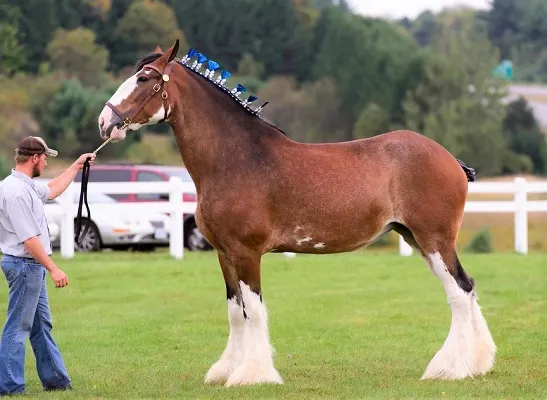
Muskoka Stock Photos / Shutterstock.com
Clydesdales are perhaps the most recognizable breed of draft horses. These stunning horses are best known for pulling the world-famous Budweiser hitch, which is truly a sight to behold.
Clydesdales typically stand between 16-18 hands tall and weigh between 1,700-2,200 pounds. They have beautiful intelligent eyes, muscular bodies, and well-arched necks. These high-stepping horses stand out with their silky white feathers and are most commonly bay in color.
Clydesdales were developed over in Scotland in the late 18th and early 19th centuries. Their ancestors include the Shire and Flemish horses that were crossed with local mares.
The appearance of the Clydesdale has changed considerably over the centuries. In the early days when the breed was used for farm work and road haulage, a heavier, stockier horse was required.
Later on, the role of the Clydesdale has shifted towards carriage driving, riding, and promotional work. As a result, breeders started developing a taller, narrower, more athletic type horse. And let’s be honest, who doesn’t love the elegant Clydesdales of the famous Budweiser commercials?
Clydesdales are also employed by the British Royal Household Cavalry as drum horses and are often marched on parades.
Percheron
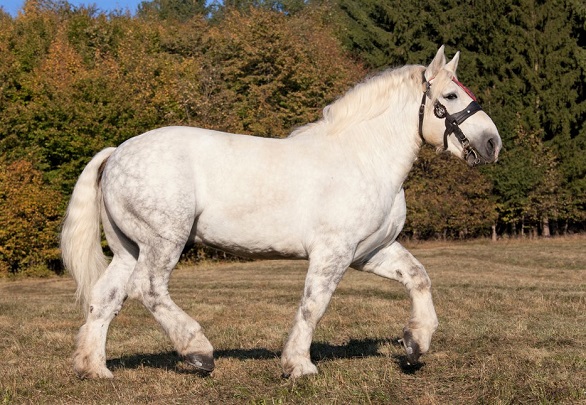
Lenkadan / Shutterstock.com
One of the oldest breeds of draft horses, Percherons originated in the province of Le Perche, which is near Normandy, France. Though their origins are not clear, these majestic horses are believed to be descendants of the Barb and Flemish horses, with Arabian blood mixed in.
Percherons generally stand between 15-19 hands tall and typically weigh between 1,800-2,600 pounds. These beautiful horses are known for their fine heads, elegant carriage, and strong muscled bodies. They are most commonly gray and black, with a powerful yet graceful way of moving.
Percherons were once used as war horses before they were used for agricultural work. First introduced to America in the mid 1800s, they quickly rose to be the most popular draft horse in the U.S. during the 1900s.
At the turn of the 19th century, the breed received an infusion of Arabian blood. This is well reflected in its refined outline and delicate features.
Their strength and stamina has allowed them to excel today as riding, driving and working horses. Combined with intelligence and willingness to work, the Percheron bears the qualities of a superb draft worker.
To this day, they are still a popular choice for forestry work and carriage driving. Its lighter cross-version makes an excellent competition or police horse.
Suffolk Punch
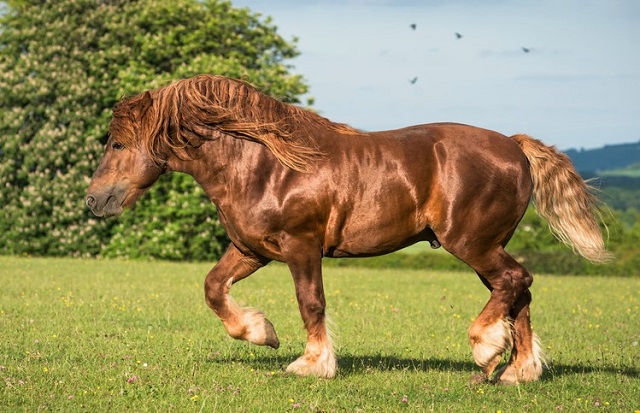
Nicole Ciscato / Shutterstock.com
The Suffolk Punch was developed for farm work and gained popularity in the early 20th century for their desirable work ethic. This sturdy breed originated in England, from Norfolk and Suffolk counties and is the oldest English breed registry.
Suffolk Punches typically stand between 15-17 hands tall and weigh between 1,600- 2,000 pounds. They are known for their large, muscular builds, thick arching necks and they are always a shade of chestnut. Today, Suffolk Punches are used for farming, logging, driving, and showing.
Suffolk Punches have long been used for agricultural work, as well as pulling heavy artillery during wartime. Up until WWII, they were a popular choice as a workhorse on large farms. Though once dropped significantly in population, their numbers are back on the rise thanks to dedicated breeding programs.
The Suffolk Punch is one of those few heavy breeds that have never been used in a carriage. Hence why the breed maintained a short, stocky appearance with a wide and muscular croup. On the other hand, they tend to exhibit an energetic, forward going trot.
Suffolk Punches are easy keepers and have a long lifespan. Their willingness to work is second to none and is admired by many.
Belgian Draft
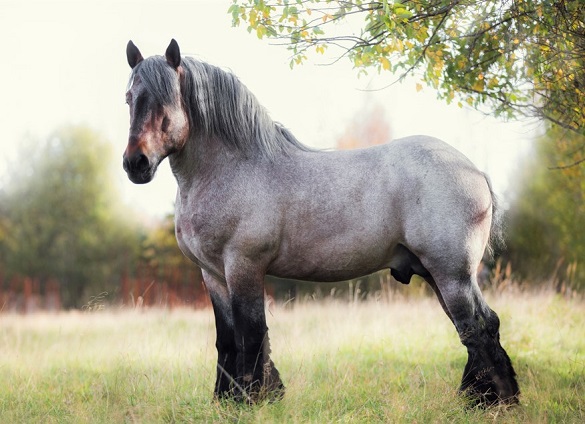
OlesyaNickolaeva / Shutterstock.com
As an old French breed, the beautiful Belgian Draft we know today came to picture in the late 1800s. Originally descended from the Great Flemish Horse during the Middle Ages, they were commonly used for war before having other heavy horses bred in to create the breed we are familiar with today.
Belgian horses often weigh between 1,800-2,200 pounds and 16-17 hands in height. However, the world record for the world’s tallest living horse currently belongs to a Belgian named Big Jake who measures at a whopping 20 hands 2.75 inches.
The breed is characterized by their strong, muscular bodies, stylish heads, and necks, light feathering, and sorrel, or roan coats, though they can come in other colors.
These blonde beauties originated in the Brabant region of Belgium. In fact, The Brabant horse and the Belgian Draft were actually the same breed for quite some time. It is only since the 1940’s that the Belgian Draft exists as an independent breed.
These horses quickly rose to popularity in America after being brought over in the late 1800s. In fact, Belgians are so popular in America that they outnumber all other draft breeds combined. Their American version is slightly taller, lighter-bodied, and of a light chestnut color.
Today they are loved for their versatility as they are commonly used for farm work, logging and driving hitches, as well as being used for showing in both riding and driving.
Haflinger
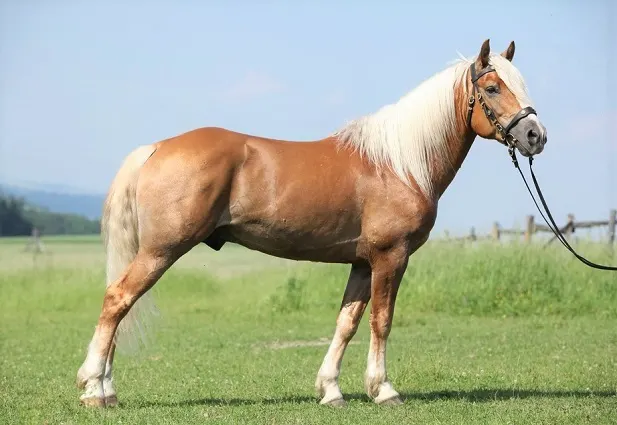
Zuzule / Shutterstock.com
The Haflinger is a light work horse breed with roots in Austria and Northern Italy. Also known as the Avelignese, it developed during the second half of the 19th century.
Some breeders distinguish two types of Haflingers: the shorter, stockier draft type and the taller, lighter riding type.
All Haflingers have a chestnut coat with a flaxen mane and tail. They’re well-muscled but have a refined read which reflects their Arabian ancestry.
The Haflinger is an extremely versatile breed, equally fit for both under saddle and draft work. They are still used by the military as packhorses on rough terrain as well as forestry work.
Because of their smooth gaits, swinging backs, and kind nature, Haflingers also make excellent therapeutic horses.
Irish Draft
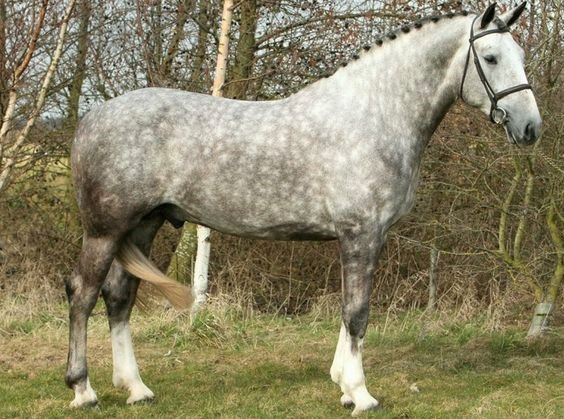
Source: stallionai.co.uk
The national horse breed of Ireland, the Irish Draft is an excellent all-round worker. Born in the 18th century Ireland from a mixture of English and Spanish breeds, it was suitable for farm work, in harness and under saddle.
After its draft function declined, the breed became a popular hunter, show, and police horse.
Other than versatility, the Irish Draft is also famous for power, athleticism, and good nature. Its warmblood cross-version, the Irish Sport Horse, is a high-quality competition breed.
The Irish Draft is a forward going horse with an active and flexible movement. It occurs in all basic colorations, however, excessive white markings are undesirable.
Ardennes

slowmotiongli / Shutterstock.com
The origins of the Ardennes date back to Ancient Rome, making it one of the oldest horse breeds in the world. It’s native to the Ardennes region which is part of modern France, Belgium, and Luxembourg.
Throughout history, the Ardennes served as a heavy cavalry and artillery horse for many nations. It is also ideal for any kind of agricultural or draft work and it’s becoming increasingly popular in competitive driving.
The Ardennes is most often bay or roan, although chestnut, palomino, and grey colors also occur. They are easy keepers with thick bones and a wide, muscular body.
Ardennes horses also played a role in the creation and refinement of other heavy horse breeds. They contributed towards the Russian Heavy Draft, Comtois, and Sokolsky horses.
Other common work horse breeds we haven’t covered include the American Cream Draft; Boulonnais; Breton; Comtois; Døle; Italian Heavy Draft; Jutland; Latvian; Muraköz; Noriker; Russian Heavy Draft.
Frequently Asked Questions What Breed of Draft Horse is the Largest?
Though it depends on the specific horse, Shires are often the largest draft horse. There have been multiple occasions where a Shire horse has held the record for the world largest living horse, including the largest horse ever.
Why is a Draft Horse Called a Draft Horse?
Draft horses got their name as the term draft is defined as the force required to pull a load or something that is pulled or drawn. Draft horse breeds are bred to have the strength to pull heavy loads, such as logging, plowing and hauling hitches.
What is the Most Weight a Single Horse Has Pulled?
In 1924, a single Shire pulled an incredible 29 tons at an exhibition in Liverpool.
Do Draft Horses Make Good Riding Horses?
Yes, draft horses can make great riding horses. Since they are so large, it is important to make sure you have the right fitting tack for them. Draft horses are often crossed with lighter breeds for a more athletic mount.
Are Draft Horses Good for Beginners?
Draft horses can make great beginner horses as they are known for their calm, easy-going temperaments. However, some beginners may be intimidated by their large size even though they are generally gentle horses.
What is a work horse?
A work horse is commonly known as a draft horse (US) or draught horse (UK). Less often, they are called a dray (Old English for dragan, meaning “to draw or haul”), carthorse, or heavy horse.
source: horseyhooves.com








